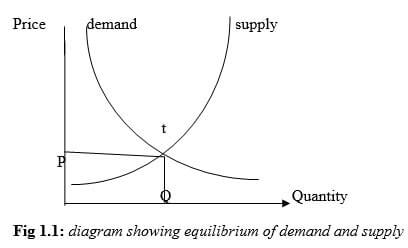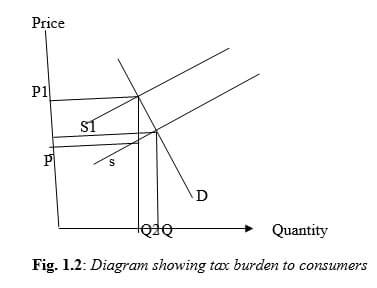Applying Supply And Demand Model to Determine Market Equilibrium
Applying Supply And Demand Model to Determine Market Equilibrium
Demand is the quantity of a good that consumers are willing to buy within a given price and within a specified period of time like several months of even a year, while all other factors that affect buying are held constant. On the other hand, supply is the amount of the available goods that the firm is willing to sell within a given period of time, while all other factors affecting firm supplying decisions are held constant. Market equilibrium is the point where the amount supplied and the amount demanded are equal (Mankiw, 2011) This results to the demand and supply curve intersecting at the centre. The figure below shows intersection at point t.

What is tax incidence?
Tax incidence is an economic term referring to the division of a tax burden between the buyers and the sellers. The concept of tax incidence is much related to the price elasticity of demand and supply rather than where the revenue is collected. It appears to be more elastic in demand that in supply. Tax incidence shows which group will pay the price of tax, be it consumers of producers. (Jain, 2010)
What determines the tax incidence?
Determinants of tax incident are;
Nature of tax
Tax can be direct or indirect. Direct taxes fall on the producers while the indirect tax fall on the consumers.
Form of market
In perfect competition markets, neither producer nor consumer affects the price thus there is no shift in of tax. Under monopoly markets, the producer is in a position to influence price and hence shifting of tax.
Cost
Tax always raises the costs of goods and supplies and hence reduces the demand which leads to lower output.
Price
Shifting of tax burden only takes place through change of price, therefore, then prices remain constant, tax too do not shift.
Elasticity
In elasticity of demand and supply, if the demand of a good is elastic, tax shifts to the producer while inelastic demand goes to the consumer. In supply, the buyer will face the burden when supply is inelastic

References
Jain, T. (2010). Micro-economics and Basic Mathematics. Market Equilibrium , 28.
Mankiw, N. (2011). Economics. Microeconomics Supply and Demand Curve , 12-31.
Buy Applying Supply And Demand Model to Determine Market Equilibrium Assignment Answers Online
Talk to our expert to get the help with Applying Supply And Demand Model to Determine Market Equilibrium Assignment to complete your assessment on time and boost your grades now
The main aim/motive of the management assignment help services is to get connect with a greater number of students, and effectively help, and support them in getting completing their assignments the students also get find this a wonderful opportunity where they could effectively learn more about their topics, as the experts also have the best team members with them in which all the members effectively support each other to get complete their diploma assignments. They complete the assessments of the students in an appropriate manner and deliver them back to the students before the due date of the assignment so that the students could timely submit this, and can score higher marks. The experts of the assignment help services at urgenthomework.com are so much skilled, capable, talented, and experienced in their field of programming homework help writing assignments, so, for this, they can effectively write the best economics assignment help services.
Get Online Support for Applying Supply And Demand Model to Determine Market Equilibrium Assignment Assignment Help Online
Resources
- 24 x 7 Availability.
- Trained and Certified Experts.
- Deadline Guaranteed.
- Plagiarism Free.
- Privacy Guaranteed.
- Free download.
- Online help for all project.
- Homework Help Services
Testimonials
Urgenthomework helped me with finance homework problems and taught math portion of my course as well. Initially, I used a tutor that taught me math course I felt that as if I was not getting the help I needed. With the help of Urgenthomework, I got precisely where I was weak: Sheryl. Read More

